Welcome to the mesmerizing world of the Orion Nebula: the birthplace of stars! This celestial wonder has captivated astronomers and stargazers for centuries, unveiling the mysteries of stellar evolution. Located in the constellation of Orion, this nebula holds a prominent place in the night sky, making it a favorite amongst both amateur and professional astronomers. In this article, we will delve into the intricacies of the Orion Nebula, its role as a stellar nursery, the formation of stars within it, breathtaking features, and the best ways to observe and study this cosmic spectacle. So let us embark on a journey through the cosmos, as we unravel the wonders of the Orion Nebula.
Contents
- 1. What is the Orion Nebula?
- 2. Formation of Stars
- 3. Features of the Orion Nebula
- 4. Observing the Orion Nebula
- 5. Telescopic Images and Studies
- Conclusion
-
Frequently Asked Questions
- 1. What are the main components of the Orion Nebula?
- 2. How big is the Orion Nebula?
- 3. Can we see new stars being formed in the Orion Nebula?
- 4. How old is the Orion Nebula?
- 5. What is the significance of the Trapezium Cluster in the Orion Nebula?
- 6. Are there any exoplanets discovered within the Orion Nebula?
- 7. Can the Orion Nebula be seen with the naked eye?
- 8. How can I observe the Orion Nebula?
- 9. What type of stars are formed in the Orion Nebula?
- 10. How has the Hubble Space Telescope contributed to our understanding of the Orion Nebula?
- References
-
Frequently Asked Questions
- FAQs about the Orion Nebula:
- 1. What is the significance of the Orion Nebula in astronomy?
- 2. How far away is the Orion Nebula?
- 3. How big is the Orion Nebula?
- 4. What is the Trapezium Cluster in the Orion Nebula?
- 5. What are the Pillars of Creation in the Orion Nebula?
- 6. Can the Orion Nebula be seen with the naked eye?
- 7. What equipment do I need to observe the Orion Nebula?
- 8. Are there any nearby viewing locations for the Orion Nebula?
- 9. How has the Hubble Space Telescope contributed to the study of the Orion Nebula?
- 10. What are some recent findings and discoveries related to the Orion Nebula?
- References
- Read More
1. What is the Orion Nebula?
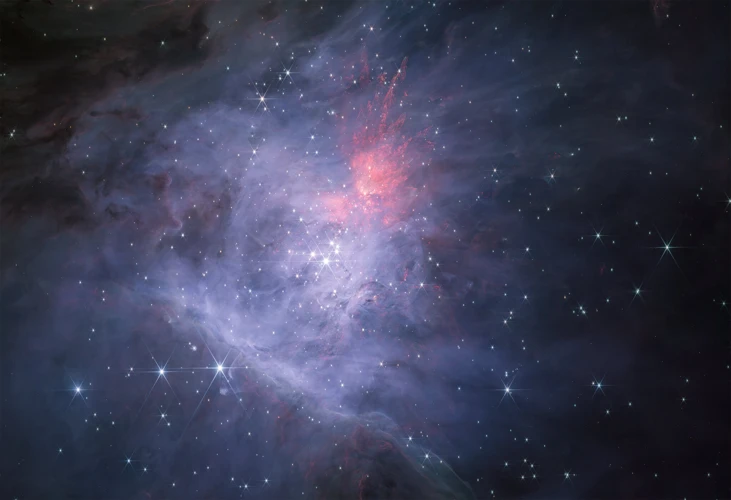
The Orion Nebula, scientifically known as Messier 42 or M42, is a fascinating marvel situated in the constellation of Orion. It is a diffuse nebula, which means it is a cloud of gas and dust spread out over a large area. The nebula is located approximately 1,344 light-years away from Earth, making it one of the closest stellar nurseries to our planet. Its proximity and brightness make the Orion Nebula easily visible to the naked eye on clear nights in the winter sky. As one of the brightest nebulae in the night sky, it has been a subject of intrigue and inspiration for astronomers, astrophotographers, and skywatchers alike. Its radiant beauty and complex features have captivated scientists for centuries, driving extensive research and observation. The Orion Nebula holds a significant place in astronomy as a remarkable stellar nursery, where new stars are born, and the secrets of the universe reveal themselves.
1.1 The Basics
The Basics of the Orion Nebula encompass its key characteristics and fundamental information. As mentioned earlier, the Orion Nebula is a diffuse nebula located in the constellation of Orion. It has an apparent magnitude of 4, making it easily visible with the naked eye. The nebula spans approximately 24 light-years across and is estimated to be around 2 million years old. Its remarkable brightness is attributed to the presence of young, hot stars within its boundaries. The Orion Nebula is primarily composed of hydrogen gas, with traces of other elements such as helium, carbon, nitrogen, and oxygen. This celestial phenomenon showcases the dynamic nature of the cosmos, with ongoing processes of star formation and gravitational interaction shaping its structure. The Basics of the Orion Nebula serve as a solid foundation to explore its captivating intricacies and unravel the mysteries of stellar birth.
1.2 Location and Visibility
The Orion Nebula is located in the constellation of Orion, which is easily recognizable by its iconic belt of three bright stars. This celestial wonder can be observed from both the Northern and Southern Hemispheres, making it accessible to stargazers around the world. In the Northern Hemisphere, it can be seen during the winter months, typically from late October to early March. For observers in the Southern Hemisphere, the best time to view the Orion Nebula is during the summer months, from late May to early September. Its location makes it particularly convenient for amateur astronomers to study and photograph, as it is visible from a wide range of latitudes. Additionally, the Orion Nebula’s brightness and size make it an ideal target for binoculars or small telescopes, allowing enthusiasts to witness its intricate features and the stunning birthplace of stars firsthand. Whether you’re an experienced astronomer or a casual sky watcher, observing the Orion Nebula is an awe-inspiring experience that connects us to the wonders of the cosmos.
1.3 A Stellar Nursery
The Orion Nebula serves as a magnificent stellar nursery, a cosmic cradle where new stars are born. Within its vast clouds of gas and dust, the process of star formation unfolds. The nebula is characterized by the presence of protoplanetary disks, which are flattened rotating disks of gas and dust surrounding young stars. These disks play a crucial role in the formation of planets. As gravity causes the material within the disk to come together, it forms clumps known as protoplanets. Over time, these protoplanets accrete more material, gradually transforming into fully-fledged planets. The Orion Nebula is a hub of activity, with numerous young stars embedded within it. These stars are often referred to as T-Tauri stars, named after the prototype star of this type. They are in the early stages of their lives, still gathering mass from the surrounding material. The energetic radiation emitted by these young stars interacts with the surrounding gas, causing it to glow and illuminate the nebula, creating a mesmerizing visual spectacle. The Orion Nebula provides astronomers with a unique opportunity to study the processes of star formation up close, shedding light on the evolution of planetary systems and the overall lifecycle of stars. Understanding the inner workings of these stellar nurseries is crucial in unraveling the mysteries of the universe and our place within it.
2. Formation of Stars
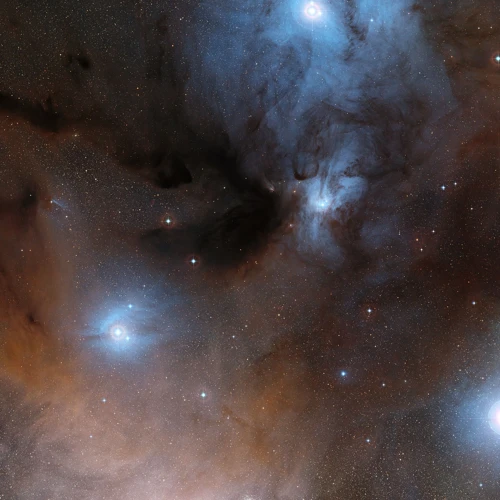
The formation of stars is a captivating and intricate process that occurs within the vast expanse of the Orion Nebula. Nebulae, such as the Orion Nebula, are enormous clouds of gas and dust scattered throughout the galaxy. These nebulae serve as the birthplaces of stars, where gravity plays a pivotal role in bringing together the materials necessary for star formation. The process begins with the gravitational collapse of a dense region within the nebula, known as a molecular cloud. As the cloud collapses under its own gravity, it begins to spin, forming a rotating disk of gas and dust surrounding a central core. As the core continues to contract, it heats up, eventually reaching temperatures and pressures high enough to trigger nuclear fusion in its core. This fusion process gives rise to the ignition of the star, marking its birth. In the Orion Nebula, this dynamic process is underway as numerous protostars form within its dense molecular clouds, and the young stars gain energy and grow in size. The formation of stars within the Orion Nebula is a mesmerizing spectacle, showcasing the remarkable power of gravity and the eternal cycle of stellar evolution.
2.1 Nebulae and Star Formation
Nebulae are vast interstellar clouds of gas and dust that exist throughout the universe. These clouds serve as the birthplaces for new stars, and the Orion Nebula is no exception. Within the Orion Nebula, the process of star formation takes place as these massive clouds undergo gravitational collapse. The initial trigger for star formation in nebulae can occur through various mechanisms, such as the compression of gas due to supernova explosions or the gravitational influence of nearby stars. As the cloud collapses under its own gravity, it begins to spin and flatten into a disk-like structure known as a protoplanetary disk. Within these disks, material continues to accumulate in the center, forming a dense core called a protostar. This protostar grows in mass and temperature, eventually reaching a point where nuclear fusion ignites, marking the birth of a true star. The remaining material in the surrounding disk can then give rise to planetary systems like our own Solar System. The intricate interplay between gas, dust, gravity, and physical processes within nebulae leads to the formation of countless stars throughout the universe, expanding our understanding of the cosmic tapestry that surrounds us.
2.2 Processes in the Orion Nebula
The Orion Nebula is not only visually stunning but also a hub of dynamic processes that drive the formation and evolution of stars. One of the key processes occurring within the nebula is gravitational collapse. As the dense regions of gas and dust in the nebula undergo gravitational collapse, they begin to form protostars. These protostars are in their early stages of formation and are surrounded by rotating disks of material known as accretion disks. Within these disks, material spirals inward, fueling the growth of the protostar. Additionally, the Orion Nebula is also home to powerful stellar winds and energetic outflows. These winds and outflows, generated by young, massive stars, play a crucial role in shaping and dispersing the surrounding gas and dust, sculpting the intricate structures visible in the nebula. Some of these structures include Herbig-Haro objects, which are formed when the outflows collide with surrounding material. These processes in the Orion Nebula provide a unique opportunity for scientists to study and understand the different stages of star formation and the complex interplay of physical forces involved.
3. Features of the Orion Nebula
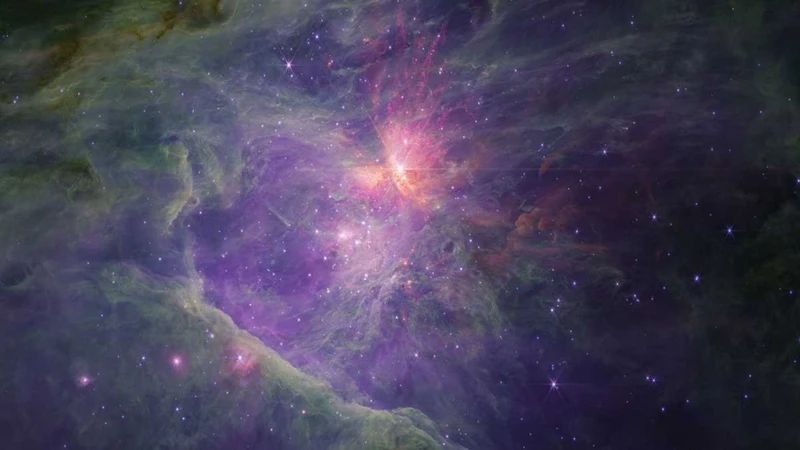
The Orion Nebula is not only visually stunning but also possesses unique and captivating features that intrigue scientists and enthusiasts alike. Let’s explore some of these remarkable characteristics:
3.1 The Trapezium Cluster: At the heart of the Orion Nebula lies a compact group of young and massive stars known as the Trapezium Cluster. This group of stars, which can be observed with a telescope, illuminates the gas and dust surrounding them, creating a breathtaking sight. The Trapezium Cluster is not only a stunning visual spectacle but also a crucial element in the study of star formation.
3.2 Pillars of Creation: Among the most iconic features of the Orion Nebula are the Pillars of Creation, reminiscent of towering structures reaching out into space. These majestic pillars are dense columns of dust and gas, where new stars are thought to be forming. Made famous by the Hubble Space Telescope’s striking images, the Pillars of Creation represent the ongoing cycle of stellar birth and serve as a testament to the beauty and complexity of the universe.
3.3 Emission and Reflection Nebulae: The Orion Nebula exhibits both emission and reflection nebulae. Emission nebulae are composed of ionized gas that emits light of various colors, producing a vibrant and ethereal glow. Reflection nebulae, on the other hand, are created when starlight reflects off dust particles, resulting in a bluish tint. Together, these nebulae create a mesmerizing display of colors and textures, adding to the allure of the Orion Nebula.
The features within the Orion Nebula offer a glimpse into the active and dynamic nature of stellar evolution. Exploring these features provides invaluable insights into the birth and development of stars within this celestial nursery. So, let us delve deeper into the mysteries hidden within the heart of the Orion Nebula.
3.1 The Trapezium Cluster
The Trapezium Cluster is a remarkable feature within the Orion Nebula that has been a focal point of scientific study and fascination. It is a young, compact cluster of stars located at the heart of the nebula. The cluster is named after its distinctive shape, resembling a trapezium when observed. Within this cluster, there are several bright and massive stars that illuminate the surrounding gas and dust. These stars are believed to have formed together from the same gas cloud, making them an excellent target for studying stellar evolution. The Trapezium Cluster is of particular interest because it contains some of the hottest, brightest, and most massive stars within the Orion Nebula. These stars emit intense ultraviolet radiation which causes the surrounding gas to glow, creating a beautiful and vibrant nebular display. The cluster also plays a crucial role in the ionization and shaping of the nebula itself. It has been a subject of extensive observation using telescopes and has provided valuable insights into the early stages of star formation and the dynamics of stellar clusters. The Trapezium Cluster is not only a fascinating feature within the Orion Nebula but also a key piece in understanding the complexities of stellar birth and evolution.
3.2 Pillars of Creation
The Pillars of Creation are one of the most iconic and awe-inspiring features of the Orion Nebula. These majestic structures are gigantic columns of gas and dust that extend several light-years into space. They were famously captured in an image taken by the Hubble Space Telescope in 1995, which became an instant sensation. The pillars serve as stellar incubators, where new stars are born from the dense molecular clouds they contain. The immense size and intricate details of the Pillars of Creation make them a subject of great interest and study among astronomers. The formation of stars within these pillars occurs as gravity causes the material to collapse, leading to the birth of protostars. Over time, these protostars evolve into fully-fledged stars, illuminating the surrounding nebula and shaping its future. The Pillars of Creation not only showcase the incredible power and beauty of the cosmos but also provide valuable insights into the processes of star formation and the evolution of the universe itself.
3.3 Emission and Reflection Nebulae
Emission and reflection nebulae are two prominent types of nebulae found within the Orion Nebula. Emission nebulae are composed of ionized gas, primarily hydrogen, that emits light of various colors. They get their distinct hues from the energy released by nearby hot and young stars. These nebulae often appear red or pink due to the presence of hydrogen-alpha emission lines. The Orion Nebula itself contains areas of intense emissions, creating a glowing and vibrant display of colors.
On the other hand, reflection nebulae do not emit their own light but instead reflect the light of nearby stars. Fine dust particles within these nebulae scatter the starlight, resulting in a blue coloration. In the case of the Orion Nebula, the reflection nebulae can be seen in the form of wispy blue regions, adding to the overall tapestry of this celestial spectacle.
Emission and reflection nebulae often coexist within the same region, creating a dynamic interplay of colorful gas and contrast. Together, they contribute to the visual splendor and complexity of the Orion Nebula, making it a captivating subject for both scientists and observers alike. Exploring these nebulae sheds light on the processes of star formation and offers astronomers invaluable insights into the birth and evolution of stars, providing a deeper understanding of the vast cosmos we inhabit.
4. Observing the Orion Nebula
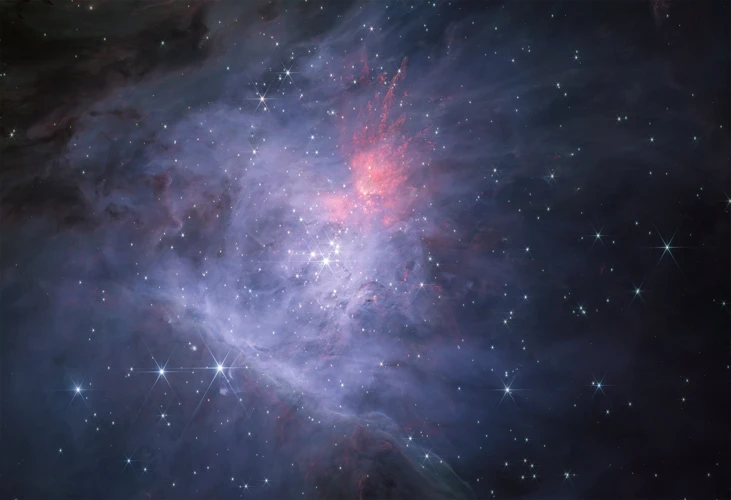
When it comes to observing the Orion Nebula, having the right equipment can greatly enhance the experience. While it is visible to the naked eye, using binoculars or a telescope will allow you to see more of its intricate details. A telescope with a larger aperture and low magnification power is recommended to get a better view. It is advisable to choose a clear night with minimal light pollution to maximize the visibility of the nebula.
To observe the Orion Nebula, first familiarize yourself with the constellation of Orion. Look for the distinctive three-star belt and locate the “sword” hanging from it. The middle “star” of the sword is actually the Orion Nebula. It appears as a fuzzy patch of light to the naked eye, but through a telescope, its true beauty emerges.
Find a comfortable observing spot and allow your eyes to adjust to the darkness. Use low magnification to take in the overall structure of the nebula. You’ll be able to see the bright central region known as the Trapezium Cluster, which contains a group of newly formed stars. The delicate wisps of gas and the intricate network of filaments surrounding the cluster will come into view.
Take your time to absorb the details and soak in the awe-inspiring sight. The colors of the nebula, primarily pink and green, are caused by different gases present within it. The nebula itself spans an impressive 24 light-years in diameter, offering a vast canvas for exploration.
Remember to document your observations through sketches or astrophotography. Capturing the beauty of the Orion Nebula allows you to revisit the experience and share it with others. Sharing your observations with astronomy communities or using apps and software to identify different features of the nebula can deepen your understanding and appreciation for this celestial wonder.
So grab your telescope, head to a dark-sky location, and prepare to be mesmerized by the intricate details and breathtaking beauty of the Orion Nebula. It’s a sight that will leave you in awe of the vastness and magnificence of our universe.
4.1 Equipment Needed
To observe the Orion Nebula in all its splendor, certain equipment is needed to enhance the viewing experience. Here is a list of the essential tools for observing this celestial wonder:
1. Telescope: A telescope is crucial for observing the intricate details and structures of the Orion Nebula. A medium to large aperture telescope, preferably with a minimum of 6 inches (15 cm) of aperture, will provide clear and detailed views.
2. Eyepieces: A collection of eyepieces with varying focal lengths is essential to achieve different magnifications and views. A low magnification eyepiece, typically between 25mm to 40mm, will offer a wider field of view to capture the entire nebula, whereas a higher magnification eyepiece, around 10mm to 15mm, will help in observing specific details and structures.
3. Filters: Filters can significantly enhance the visibility of specific features within the Orion Nebula. A nebula filter, such as a hydrogen-beta filter, can help in isolating the emission nebula and enhancing the contrast of its structure. A light pollution filter can also be useful to mitigate the effects of light pollution and improve the visibility of faint details.
4. Mount: A stable and sturdy mount is essential to keep the telescope steady during observation. A motorized mount, such as an equatorial mount, can be beneficial for tracking the movement of the Orion Nebula across the night sky.
5. Binoculars: While a telescope offers detailed views, using binoculars can provide a wider field of view, allowing you to take in the entire Orion Nebula and its surroundings. A pair of binoculars with good light-gathering capabilities, such as 10×50 or 7×35, can enhance the visual experience.
Make sure to set up your equipment in a location with minimal light pollution to achieve optimal viewing conditions. Remember to dress warmly and allow your eyes to adjust to the darkness. With the right equipment and a clear night sky, you can embark on an incredible journey to explore the breathtaking beauty of the Orion Nebula.
4.2 Best Viewing Locations
When it comes to observing the Orion Nebula, finding the right location can greatly enhance the viewing experience. Here are some of the best locations for observing this celestial beauty:
1. Dark Sky Reserves: Dark sky reserves, areas designated for their minimal light pollution, provide optimal conditions for stargazing. Places like the Dark Sky Park in Michigan, USA, or the Brecon Beacons National Park in Wales, UK, offer breathtaking views of the night sky, including the Orion Nebula. These locations prioritize preserving the natural darkness and provide visitors with unobstructed views of the stars.
2. High Altitude Sites: Higher altitudes typically have clearer skies and less atmospheric interference, making them ideal for observing astronomical objects like the Orion Nebula. Mountains or observatories situated at high altitudes, such as Mauna Kea in Hawaii or the Atacama Desert in Chile, offer excellent opportunities for observing celestial wonders.
3. Remote Areas: Getting away from city lights to remote areas away from light pollution can significantly enhance the visibility of the Orion Nebula. National parks, rural areas, or areas with limited development and artificial lighting provide a clearer view of the night sky, allowing for a more immersive experience.
4. Amateur Astronomy Clubs: Joining local astronomy clubs or societies can provide valuable insights into the best viewing locations specific to your area. These clubs often organize star-gazing events in remote or dark sky locations, where members can gather to observe and share their passion for astronomy.
It is important to note that regardless of the location, checking astronomical weather forecasts and planning your viewing session during clear nights with minimal cloud cover is essential. Remember to allow your eyes ample time to adjust to the darkness for the best possible viewing experience of the mesmerizing Orion Nebula.
5. Telescopic Images and Studies
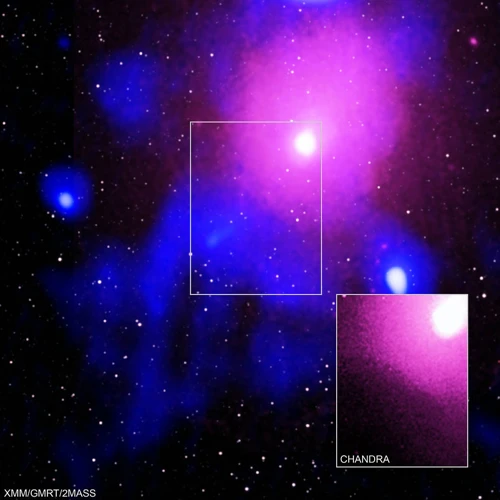
Telescopic images and studies of the Orion Nebula have provided scientists with invaluable insights into the intricate details of this stellar nursery. With advancements in technology and the advent of powerful telescopes, astronomers have been able to capture breathtaking images of the nebula, revealing its complex structure in stunning detail. The Hubble Space Telescope, known for its remarkable contributions to space exploration, has played a significant role in studying the Orion Nebula. Its high-resolution images have uncovered a wealth of information about the formation and evolution of stars within the nebula. Researchers have used these images to identify and study various features, including the famous “Pillars of Creation,” which are giant columns of gas and dust where new stars are being born. Additionally, telescopic observations have allowed scientists to study the motion and dynamics of the gas clouds, providing clues about the processes at work in the Orion Nebula. These detailed studies have contributed to our understanding of stellar evolution and the birth of stars in this awe-inspiring cosmic environment.
5.1 Hubble Space Telescope’s Contribution
The Hubble Space Telescope has played a pivotal role in our understanding of the Orion Nebula, providing us with remarkable insights and breathtaking images. Since its launch in 1990, the Hubble telescope has been instrumental in capturing the intricate details and structures within the nebula. Its high-resolution images have allowed scientists to study the formation of stars within the nebula with unprecedented clarity. The telescope’s observations have revealed the intricate dynamics of the nebula, including the movement and interaction of its gas clouds and the processes involved in star birth. One of the most significant discoveries made by the Hubble Space Telescope is the presence of protoplanetary disks within the Orion Nebula. These disks contain the building blocks for the formation of planets, shedding light on the origins of planetary systems like our own. The Hubble’s contributions to the study of the Orion Nebula have opened up new avenues of research and deepened our understanding of stellar evolution. Its images continue to inspire awe and fascination, inviting us to marvel at the cosmic wonders that lie within our reach.
5.2 Recent Findings and Discoveries
Recent findings and discoveries regarding the Orion Nebula have provided astronomers with invaluable insights into the processes of star formation and the evolution of young stellar systems. One of the most significant discoveries in recent years has been the identification of a multitude of protoplanetary disks within the nebula. These disks, made up of gas and dust, are the birthplaces of potential planetary systems. Scientists have been able to observe the complex structures and dynamics of these disks, shedding light on the early stages of planet formation. Additionally, studies have revealed the presence of large, turbulent gas flows within the nebula, which play a crucial role in redistributing material and triggering the formation of young stars. Another noteworthy finding is the detection of organic molecules, including complex hydrocarbons, in the vicinity of newly forming stars within the Orion Nebula. This discovery bolsters the idea that the building blocks of life exist in regions where stars are born, raising intriguing questions about the origins of life in the universe. With ongoing advancements in observational techniques and technologies, scientists anticipate further revelations and breakthroughs in understanding the intricate nature of the Orion Nebula and its role in the cosmic tapestry.
Conclusion

In conclusion, the Orion Nebula continues to fascinate and captivate both professional astronomers and amateur skywatchers. Its role as a stellar nursery, where new stars are born, sheds light on the intricate processes of stellar evolution. Through studying the Orion Nebula, scientists have gained invaluable insights into the formation of stars and planetary systems. The nebula’s stunning features, such as the Trapezium Cluster and the Pillars of Creation, have been immortalized in breathtaking images captured by telescopes like the Hubble Space Telescope. As our understanding of the Orion Nebula deepens, so does our appreciation for the vast beauty and complexity of the universe. So, whether you are an enthusiast peering through a telescope or simply gazing up at the night sky, the Orion Nebula offers a mesmerizing glimpse into the secrets of the cosmos. To learn more about other celestial phenomena and their significance in different cultures, you may be interested in exploring the fascinating connections between planetary alignments and astrological beliefs by clicking here.
Frequently Asked Questions

1. What are the main components of the Orion Nebula?
The Orion Nebula consists of hydrogen gas, helium, and dust particles. These elements combine to form the colorful clouds and structures that we see in the nebula.
2. How big is the Orion Nebula?
The Orion Nebula spans an area of approximately 24 light-years across. This vast size makes it one of the largest known emission nebulae in the night sky.
3. Can we see new stars being formed in the Orion Nebula?
Yes, the Orion Nebula is a stellar nursery where new stars are actively being formed. Astronomers have observed protoplanetary disks, massive molecular clouds, and other signs of ongoing star formation within the nebula.
4. How old is the Orion Nebula?
The Orion Nebula is estimated to be around 2 million years old. This relatively young age in astronomical terms makes it a prime location for studying the early stages of star formation.
5. What is the significance of the Trapezium Cluster in the Orion Nebula?
The Trapezium Cluster is a cluster of hot young stars located in the heart of the Orion Nebula. These stars emit intense ultraviolet radiation, which ionizes the surrounding gas and creates the glowing appearance of the nebula.
6. Are there any exoplanets discovered within the Orion Nebula?
As of now, no exoplanets have been directly discovered within the Orion Nebula. However, astronomers continue to study the nebula for any potential planetary systems forming within its dense molecular clouds.
7. Can the Orion Nebula be seen with the naked eye?
Yes, the Orion Nebula is visible to the naked eye under ideal conditions. It appears as a hazy patch of light just below Orion’s Belt, making it a popular target for stargazers and astrophotographers.
8. How can I observe the Orion Nebula?
To observe the Orion Nebula, you can use binoculars or a telescope with low magnification. Look for Orion’s Belt, and you will easily spot the glowing nebula below it. It is best observed during clear winter nights when Orion is high in the sky.
9. What type of stars are formed in the Orion Nebula?
The Orion Nebula gives birth to a variety of stars, ranging from low-mass stars like our Sun to high-mass stars several times more massive. This diversity in star formation makes the nebula an excellent laboratory for studying stellar evolution.
10. How has the Hubble Space Telescope contributed to our understanding of the Orion Nebula?
The Hubble Space Telescope has provided stunning and detailed images of the Orion Nebula, revealing intricate structures, protoplanetary disks, and regions of intense star formation. Its observations have greatly enhanced our understanding of the processes involved in star birth and the formation of planetary systems.
References
Frequently Asked Questions

FAQs about the Orion Nebula:
Here are some frequently asked questions about the Orion Nebula:
1. What is the significance of the Orion Nebula in astronomy?
The Orion Nebula is significant in astronomy because it serves as a prime example of a stellar nursery where new stars are born. It allows scientists to study the processes of star formation and gain insights into the early stages of stellar evolution.
2. How far away is the Orion Nebula?
The Orion Nebula is located approximately 1,344 light-years away from Earth. This makes it one of the closest stellar nurseries to our planet.
3. How big is the Orion Nebula?
The Orion Nebula has a diameter of about 24 light-years. It spans a vast region of space and contains a complex network of gas, dust, and young stars.
4. What is the Trapezium Cluster in the Orion Nebula?
The Trapezium Cluster is a cluster of young, hot stars located at the heart of the Orion Nebula. It is named after its distinctive arrangement of four bright stars that form a trapezoid shape.
5. What are the Pillars of Creation in the Orion Nebula?
The Pillars of Creation are long, narrow columns of gas and dust within the Orion Nebula. These pillars are illuminated by the nearby stars and serve as the birthplaces of new stars.
6. Can the Orion Nebula be seen with the naked eye?
Yes, under dark sky conditions, the Orion Nebula is visible to the naked eye as a faint, fuzzy patch of light. It is best seen during the winter months in the Northern Hemisphere.
7. What equipment do I need to observe the Orion Nebula?
To observe the Orion Nebula, you will need a telescope with a moderate to high magnification capability. Additionally, using filters can enhance the visibility of certain features within the nebula.
8. Are there any nearby viewing locations for the Orion Nebula?
The Orion Nebula can be observed from various locations around the world, as long as the sky is dark and clear. Some recommended viewing locations include observatories, national parks, and remote areas away from city lights.
9. How has the Hubble Space Telescope contributed to the study of the Orion Nebula?
The Hubble Space Telescope has provided astronomers with incredibly detailed images of the Orion Nebula, revealing intricate structures and processes within the nebula. Its observations have led to groundbreaking discoveries and a better understanding of stellar birth.
Recent studies of the Orion Nebula have unveiled the presence of protoplanetary disks around young stars, hinting at the potential for planet formation. Researchers have also identified complex organic molecules within the nebula, raising questions about the origins of life in the universe.







